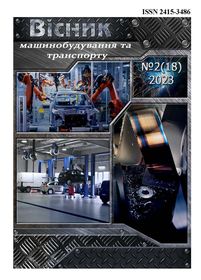Improvement of the mechanism of lapping with a free abrasive by using a silicate composition
DOI:
https://doi.org/10.31649/2413-4503-2023-18-2-94-100Keywords:
silicate paste, lapping mechanism, research result, lapping performance, abrasive grain, amorphous silica, surface quality.Abstract
The results of an experimental study are presented that explain and confirm the mechanism of lapping friction surfaces with a silicate abrasive composition.
It is shown that the stability of the silicate lapping paste over time can be achieved by introducing ferric trichloride (FeCl3), which in this case is a thickener of liquid glass and also has high hygroscopic properties. The adhesive properties of the silicate paste are improved by the addition of lubricant 1-13. This grease was chosen due to its water solubility. To increase the abrasive ability of the silicate paste, an abrasive powder was introduced.
It was found that the lapping performance of the silicate composition and the quality of surfaces are higher than when treated with the «KT» paste, which is currently used for lapping automobile engine valves. Based on the results of the study, the mechanism of lapping friction surfaces with a silicate paste is presented. The mutual movement of the surfaces results in cutting and scratching of the highest peaks of the bumps by the abrasive grains. When silicon oxide (SiO2) is added to the abrasive material, its particles are coated with silicon oxide. This is because liquid glass solutions have a high adhesive force and low surface tension. At the points of contact between the abrasive particles, the temperature rises, and since there is SiO2 around the abrasive, when the latter enters the contact zone, amorphous silica (SiO2) is formed. Since the abrasive grains are coated with a silicon oxide film, SiO2 penetrates into the cavities of micro-irregularities and adheres to the surface under repeated exposure to the abrasive. Thus, the surface to be treated is saturated with silicon oxide, which leads to an increase in its quality after grinding with a silicate composition.
It has been proven that high surface quality is formed by amorphous silica. To confirm this mechanism, chemical and X-ray spectral analyses of the samples were performed, which showed the presence of SiO2 on the treated surface and a "strong bond" of silicon compounds with the metal surface layer.
It was found that the high quality of the surface is also due to the shape of abrasive particles and wear products. It has been confirmed that with the variable movement of surfaces relative to each other, abrasive grains take on a new position each time. At the same time, they are worn from all sides and acquire a rounded shape, and are simultaneously enveloped by a SiO2 foil.
References
Експериментальне дослідження можливості використання силікатної пасти для підвищення довговічності деталей автомобільних двигунів / В. А. Макаров та ін. Вісник машинобудування та транспорту. 2023. № 1(17). С. 92–98
Притирання ущільнюючих поверхонь. [Електронний ресурс]. URL: http://ni.biz.ua/7/7_14/7_144327_pritirka-uplotnitelnih-poverhnostey.html
Виноградов Н. С. Исследование возможности использования силикатной пасты для притирки сопряженных деталей. Вісті Автомобільно-дорожнього інституту: науково-виробничий збірник. 2006. № 1. С. 70–74.
Експериментальне дослідження впливу зернистості абразиву силікатної пасти на якість поверхонь тертя / Макаров В. А. та ін. Вісник машинобудування та транспорту. 2022. №1(15). С. 100–105.
Downloads
-
PDF (Українська)
Downloads: 30



